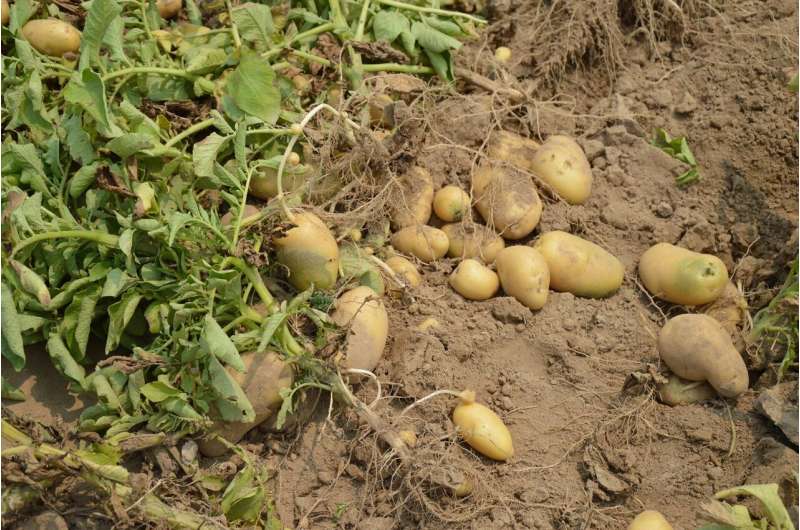This article has been reviewed according to Science X's editorial process and policies. Editors have highlighted the following attributes while ensuring the content's credibility:
fact-checked
proofread
Evidence-led GM crop regulation could help UK take lead in tackling global food security, climate change risks

The U.K. needs an evidence-led and proportionate regulatory approach for genetically modified (GM) crops to realize the technology's benefits for human health, agriculture and the environment, according to a new Royal Society policy briefing.
The "Enabling genetic technologies for food security" briefing, led by Professor Jonathan Jones FRS, Group Leader at The Sainsbury Laboratory, Norwich, sets out recent developments in using the GM method for crop improvement. This has seen the technology used in a growing number of countries to enhance resistance to pests and diseases, improve nutrition and elevate tolerance to heat and drought.
Genetic modification, for the purposes of U.K. crop regulation, involves moving genes between species and is regulated differently to other breeding technologies which make genetic changes within a species.
The U.K.'s leading plant scientists and expertise in commercial crop breeding mean it is well placed to deliver the benefits of deploying this technology. Discoveries made by U.K. scientists have already been commercialized in other countries, but not in the U.K. A more supportive regulatory approach in the U.K. would boost innovation and result in new applications of GM methods that benefit the British public and global food security.
Earlier this year, the U.K. government has already sought to reduce regulatory barriers to genetic innovation for agriculture by passing the Genetic Technology (Precision Breeding) Act, which introduced a new framework in England for regulating crops that were gene edited.
However, the Act left GM crops under a regulatory regime inherited from the EU which has usually required extensive scientific and safety trials. Satisfying these requirements is so expensive that only the largest companies can achieve regulatory approval.
The Royal Society briefing argues this approach is no longer justified given the evidence from 30 years of commercial use that crops developed with GM methods are no more likely to pose unpredictable risks than crops resulting from other breeding technologies. Instead, regulation should focus on assessing scientifically plausible risks given what is known about the GM trait and the species it was introduced into.
In adopting this approach, the U.K. can learn from other regulators that have greater experience with GM technology, such as the U.S. To support greater innovation, the U.S. Department of Agriculture recently reformed the way it assesses environmental risks from GM crops such that crop developers do not need to invest in extensive risk assessment if there is no scientific reason to believe that the crop is likely to cause an environmental harm.
The first GM plant approved in the U.S. under its new framework was developed by U.K. researchers at the John Innes Center, Norwich: the "purple tomatoes," developed using genes from the snapdragon plant, which have higher concentrations of health-supporting anthocyanins.
GM methods enable applications that would not be possible with other methods and could be particularly important for reducing the environmental impact of agriculture while providing enough food for a rising population. These methods hold great potential in adapting crops to the pressing challenges posed by climate change, pests, diseases, biodiversity loss and invasive species.
"We need to feed people properly without destroying the planet," said Professor Jones, whose research spans a range of GM applications, including potatoes resistant to late blight disease, which farmers currently spray 15–20 times a year to control.
"Manufacturing and spraying fertilizers and pesticides results in a significant carbon footprint and collateral damage to non-target insects and the wider ecosystem. Using GM methods, we can replace chemistry with genetics for pest and disease control.
"GM is one arrow in our quiver, but one we cannot afford to spurn. The lesson from countries that have used this technology for 30 years is that its potential risks can be regulated on the basis that they are predictable and specific to the change being made."
Examples of GM applications being developed in the U.K. and around the world:
- Pest and disease resistance—Late blight costs U.K. potato farmers about £50m a year in crop losses and fungicide treatments. The blight resistant variety of Maris Piper potato developed by The Sainsbury Laboratory contains genes from species in the same Solanum genus as domesticated potatoes and that are already deployed in the U.S. Other examples include insect resistant aubergines for Bangladesh and the Philippines, insect resistant cowpea in West Africa, tomatoes and potatoes resistant to viruses and bacterial wilt, and wheat resistant to stem rust.
- Improving yields and reducing fertilizer dependence—Researchers at the Crop Science Center, Cambridge, are testing GM barley modified with genes from the leguminous plant, Medicago truncatula, that enhance access to soil nutrients through symbiotic association with soil fungi. This could help reduce applications of fertilizers and their environmental impacts on soil and river ecosystems.
- Adapting to environmental change—A drought resistant wheat variety, modified with a gene from sunflowers, was developed in Argentina and has been approved for cultivation in Brazil and certified safe for human consumption in Australia, Brazil, Columbia, New Zealand, Nigeria and the U.S.
- Removing heavy metals or explosive contaminants from soil—In a three-year field trial, the University of York's Center for Novel Agricultural Products, working with the U.S. Department of Defense, demonstrated a genetically modified native grass species (Panicum virgatum) can effectively remediate soils contaminated with explosive residues.
More information: Enabling genetic technologies for food security. royalsociety.org/-/media/polic … -policy-briefing.pdf
Provided by Royal Society





















